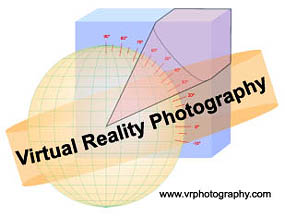by Scott Highton ©2015
 |
Scott Highton has been a VR photographer for over 20 years. He is the author of the 2010 seminal book: Virtual Reality Photography (ISBN 978-0-615-34223-8), and served as the original photography consultant to both Apple and IPIX during development of their respective QuickTime VR™ and IPIX™ technologies. He was the first to shoot with both technologies underwater and in other extreme environments.
He wrote this perspective for the Virtual Reality Photography web site in July, 2015.
![]()
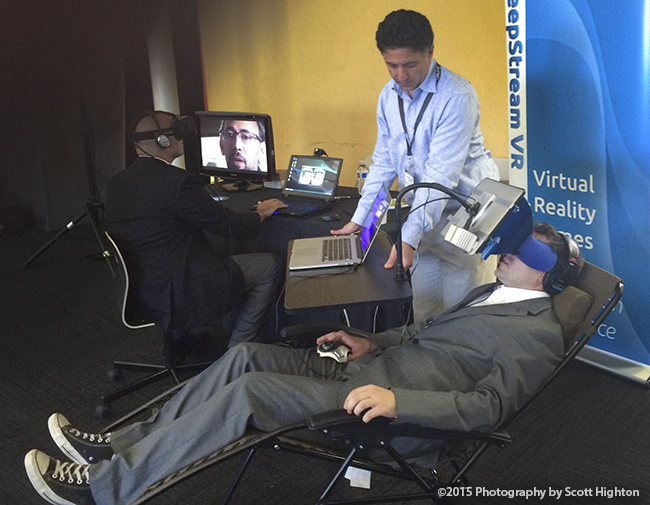
![]()
Renewed excitement over virtual reality (VR) has now been underway for close to two years. Technology corporations, large and small, seem to be falling all over themselves in their efforts to get in on the action. The industry is abuzz with the potential for VR and augmented reality (AR). Billions of dollars are being spent acquiring promising technologies, and on R&D.
Many of us have been through this before, and many of us are concerned that lessons learned from our industry’s past are being forgotten as a new generation embraces the possibilities of VR.
VR has been around for decades, first in the realm of high-end science fiction, and then in the worlds of supercomputing and well-funded entities like NASA. In the mid ‘90s, Apple released the first consumer VR technology – QuickTime VR (QTVR). This was quickly followed by other applications, which expanded or improved the capabilities of QTVR – larger (spherical) fields of view, higher resolutions, and even the inclusion of motion imagery. All of these were primarily targeted toward the consumer who would view VR content on their computer screens (most of which were desktop systems at that point). Content delivery was primarily via CD-ROM, as broadband and the Web itself were still in their relative infancies.
VR (in the '90s) was exciting because it was interactive. It was new. It held so much potential. |
For the most part, VR was experienced through postage stamp sized windows on 640 x 480 pixel CRT screens. VR was exciting because it was interactive. It was new. It held so much potential. The low quality was tolerated because everyone knew it would get better as time passed. Almost every major industry embraced the technology initially – from automotive to retail, from travel and hospitality to aviation, medicine, real estate, communications, media, and entertainment.
Ultimately however, realities of VR set in. Bandwidth became a major restriction. It was not possible to deliver the quality and resolution needed to take the VR experience beyond basic novelty because of the limited bandwidth available. Both CD-ROM and DVDs fell into disuse because they were so much more costly than the internet for content distribution, and updates were cumbersome.
VR producers also found it difficult to justify the significant work and expense involved in creating VR content for audiences, who were often just as effectively served with more traditional technologies. For example, what is the point of a high-end hotel spending tens or hundreds of thousands of dollars to produce an interactive VR tour of their property, when potential guests are just as effectively informed about the quality of the rooms and facilities with still photographs and text? Consider this from the hotel's return on investment (ROI) point of view – the bottom line for any business. Production costs are significantly lower with traditional photography, and the use of VR in online promotion doesn’t effectively translate into more bookings or an ability to charge higher rates for rooms. Furthermore, due to a lack of formatting standards (i.e. QTVR vs. Flash vs. proprietary plug-ins vs. HTML5, etc.), VR content was not reliably displayed on every user’s computer.
In spite of its tremendous potential in the late 1990s, VR pretty much fizzled as a consumer technology within five or 10 years.
![]()
At first glance today, things seem different. Broadband internet is available to the vast majority of homes and businesses, as is efficient streaming technology. The delivery of high-bandwidth content, for the most part, is a non-issue.
High definition video screens (HD, 2K, 4K, even 8K) are now standard, not only in our living rooms, but on our desktops and mobile devices, as well. Even low cost digital cameras, including those in our phones, can record both still and video imagery at resolutions sufficient for these high res displays. There are countless software applications available for producing, editing, and delivering content effectively to these high res screens.
But after two years of renewed excitement over the potential of VR and AR, I think we need to reconsider where we’re collectively heading with it.
![]()
The resulting experience is much like watching an old CRT television screen from across the room with a pair of binoculars strapped to your head. |
The area where VR seems to be getting the most attention today comes from its delivery via VR headsets or head mounted displays (HMDs). Many are touting this as the next big thing in gaming. There are dozens of companies promoting their VR/AR technology advances in the form of headset systems – from inexpensive Google Cardboard to higher resolution devices like the Facebook / Oculus Rift. Oculus, which is not even commercially available yet, specifies a hard wire cable connection to a Windows computer or game console – a significant restriction from many user perspectives.
Perhaps the biggest problem is that today’s HMDs seem to be a huge step backward for immersive viewing experiences. Stereoscopic viewing is generally accomplished by splitting visual content into two halves of a smart phone screen, and then adding a magnifying lens for each eye. This enables stereo (binocular) viewing.
The resulting experience is much like watching an old CRT television screen from across the room with a pair of binoculars strapped to your head. You see the individual pixels or screen dots (many have called this the “screen door effect”), the resolution is unacceptably low, your field of view is far too narrow, focus is usually poor, while screen flicker and latency of movement (a delay between moving your head and corresponding movement on screen) cause varying degrees of motion sickness. None of these are acceptable to audiences, who are accustomed to viewing visual content on high definition (HD) and ultra-high definition (UHD) screens. When you add poor quality sound from cheap headphones, the whole experience is one that many will walk away from in disappointment.
Of course, users who wear glasses have further discomfort and limitations in their HMD viewing experiences. The initial novelty of simply being able to look in any direction goes away quickly – just as it did with the postage stamp sized screens, jumpy playback, limited fields of view, and low resolution displays of VR in the ‘90s.
There’s also an unfortunate social disconnect that occurs when viewers retreat into virtual cocoons of headset VR to interact with their virtual worlds. HMDs intentionally isolate the user and block out normal stimuli of life around us. The idea of having a shared experience, which is what most of us enjoy doing in life, becomes far more limited, unless you consider interacting with avatars or hunting bad guys in synthetic virtual worlds your idea of social interaction.
...VR headsets are ultimately destined for the dustbin of consumer products.The bottom line is that people really don’t like having a restrictive visual device strapped to their faces... |
Certainly, there will be vertical markets where good quality VR headsets (well beyond what we’re seeing today) will find a place, such as in training simulations, medical or psychological treatments, and remote control operations like drone piloting and bomb disposal. First person view (FPV) headsets are all the rage for pilots/operators in the new “sport” of drone racing, and several companies are using VR headsets to both help patients manage pain and to aid with medical protocols.
But for the most part, I believe that VR headsets are ultimately destined for the dustbin of consumer products. The bottom line is that people really don’t like having a restrictive visual device strapped to their faces – and certainly not for extended periods (5-10 minutes is a common maximum tolerance).
Consider the long history of similar HMD-type viewers.
Stereoscopes utilizing black and white stereographic cards were briefly in vogue during early years of photography because they delivered a visual experience that was unlike any other at the time. But holding the stereoscope up to one’s face and manually changing cards provided only limited entertainment.
These were followed by moving picture arcade systems, where viewers looked into a pair of lenses mounted on a box containing a large cylinder of stereographic cards that flipped by, providing the effect of a 3D moving picture. That novelty wore off quickly, as well. The most popular ones were titillating sequences of partially clad women performing strip teases – likely representing the beginnings of the porn film industry.
Other headset-type devices followed. They included the View-Master and its disks of stereo images, anaglyph (red and cyan) glasses for viewing 3D imagery, polarized and related glasses systems including those that fell flat for 3D film and television during the last few years. All of these have led up to today’s crop of HMDs. Even Google’s Glass technology (which was not intended as a VR viewing device) failed, because attaching something unusual to one’s face, particularly for extended periods, is neither comfortable nor socially attractive.
About the only acceptable reasons for putting "devices" in front of our eyes are for vision correction, getting a closer look with binoculars and telescopes, and snorkeling or scuba diving. Even so, the first thing that most divers do when they surface is to quickly remove their face masks.
VR headsets today are generally uncomfortable, less-than-hygenic... as well as headache and motion sickness inducing. |
VR headsets today are generally uncomfortable, less-than-hygenic (especially if being shared by multiple users), as well as headache and motion sickness inducing. They deliver a far cry from the image quality modern audiences have come to expect. It seems truly short sighted for the industry to focus on HMDs as the primary viewing platform for the future of VR. The fact that VR headsets basically put their users into a cocoon of limited movement and isolation from real life also does not offer us a hopeful future for social interactions or experiencing real life.
![]()
![]()
UploadVR’s Founder+ Investor Demo Day
In early July, I had the opportunity to attend UploadVR’s Founder+ Investor Demo Day at the Computer History Museum in Mountain View, CA. This was an event organized by UpLoadVR to bring VR technology startups together with the industry’s most active venture capitalists. Eleven promising startups were selected to make public “elevator pitches” to a panel of investor judges, and startup prizes of up to $25,000 would be awarded by Boost VC at the end of the day. Investors could also meet privately with companies displaying their technologies at the event. Since much of the process was accessible to invited attendees, the experience was quite an eye opener into the current development directions of VR and AR.
The majority of the technologies demonstrated at Demo Day incorporated the use of VR headsets (primarily Samsung’s Gear VR). Overall, the experience with these was disappointing for all the reasons mentioned previously. Very little of the content shown, including at least one “world premiere,” was created photographically. Most were CGI rendered experiences, and most of these were rather primitively done. With the tremendous availability of Hollywood level CGI applications and artists working today, it seems self-defeating to be pitching mediocre quality VR imagery to big money investors.
The lack of motion photographic VR imagery presented by these startups is understandable so far, as there is only limited hardware that can produce quality, high-res motion photographic VR content. For the most part, the popular arrays of GoPro and similar consumer cameras like the Ricoh Theta, aren’t really up to the demands of high quality 360° cinematic VR. Use of high-end multi-camera rigs is extremely expensive, and there’s not much of an opportunity for any ROI without access to consumer dollars yet. Certainly, some of these limitations will change as better quality consumer-level VR displays are released, and with larger companies like GoPro, Nokia / Microsoft, and Google investing heavily in motion VR capture system development.
Read The 360° Video Conundrum – Cinematic VR Considerations at: http://www.vrphotography.com/360videovr/
![]()
![]()
UpLoadVR co-founder Nick Ochoa introduced the startup pitch session with a brief overview of the current state of the VR industry based on UploadVR and GreenlightVR research. Ochoa’s most pointed comment was, “There is no consumer market for VR yet. It’s still developer-only based.”
A May, 2015 Piper Jaffray report on the VR industry predicted that VR and AR are “the next mega tech themes through 2030,” with predicted market size (from content alone) of $5.4 billion by 2025. Piper Jaffray expects the lion’s share of these revenues will come from video games, the NFL, and adult content. Lesser, but still significant percentages will be earned from movies, the NBA, and live concerts.
Piper Jaffray also expects VR hardware sales to be $62 billion in 2025 (based on an estimated 500 million headsets selling for an average price of $125).
![]()
Winners of the UploadVR and Boost VC funding prizes were as follows:
1st – Cerevrum, for their brain technology and learning games.
http://www.cerevrum.com
![]()
2nd – Floored, for their 3D and VR software, intended to replace bad photography and floor plans so prevalent in the real estate and retail online markets.
http://www.floored.com
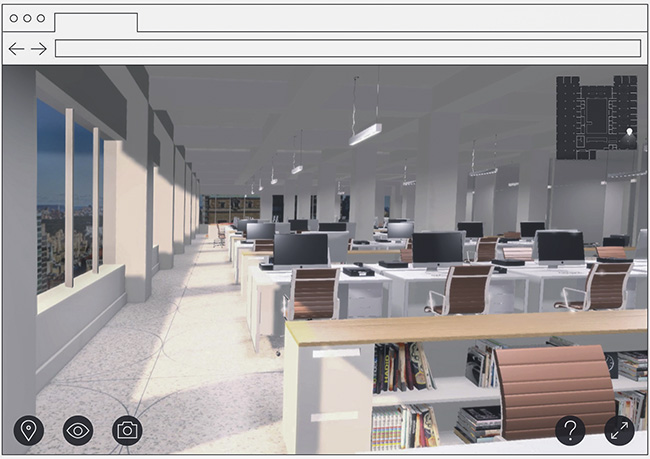 |
Image courtesy: Floored |
3rd – Otherworld Interactive, for their VR content (experiences and games).
http://otherworldinteractive.com
When questioned by the panel of investor judges, executive producer Andrew Goldstein said that he saw premium (paid) content as the driving force for VR / AR funding and income. However, he added, “monetization is going to take a while.”
![]()
Beyond the winners, there were many other promising concepts presented.
Among the most compelling, I felt, were the companies that were using VR for medical purposes. One was Vivid Vision, which uses VR for vision care and a possible “cure” for lazy eye or amblyopia. Unfortunately, founder Manish Gupta’s “pitch” at the conference focused more on how much doctors could charge their patients for the technology, rather than on the contribution to society the technology could provide. (Of course, the pitch was aimed at investors looking for a financial ROI.) One caveat was that the system doesn’t appear to be effective for patients beyond a relatively young (childhood) age.
http://www.seevividly.com
![]()

The second was Deepstream VR, which utilizes VR games for pain relief and wellness. Their demo system employed a large headset system containing a tablet, rather than a smart phone, which increased the image resolution and field of view to make the experience more visually realistic. However, the size and weight of the headset meant it had to be supported by a desktop arm, with the patient confined to reclining in an easy chair.
http://deepstreamvr.com
![]()
LivelikeVR has targeted the sports market with what appears to be an “almost VR” approach, wherein a virtual living room is projected within the user’s VR headset. A traditional live action broadcast of a sports event (using present day broadcasting feeds) is projected on the entirety of the room’s front wall, simulating the effect of watching the game on a huge screen. Of course, you’re only able to view this within the limited resolution of your VR headset, so the stunning detail of a wall-sized 4K or 8K UHD monitor is completely lost. The side and back walls of the virtual room are used to display game stats, instant replays, etc. You simply turn your head when you want to see this material, again provided from existing broadcast content. LivelikeVR’s pitch is primarily directed at sports broadcasters, allowing them to enter the VR broadcast market using existing camera and other coverage equipment, and they said Champions League Soccer will be using their technology next season.
http://www.livelikevr.com
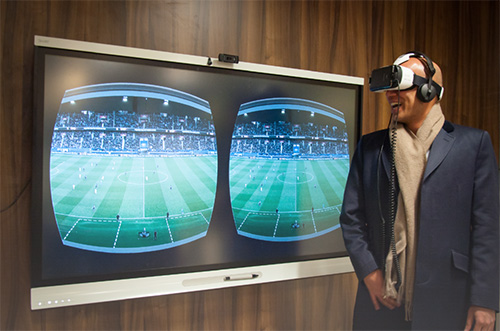 |
Image courtesy: LivelikeVR |
LivelikeVR takes a somewhat different approach than most VR sports efforts, which try to put the viewer in the middle of the action with on-field camera arrays. LivelikeVR’s CEO Andre Lorenceau rightly argued that there’s little value to the average sports viewer of being VR “immersed” in the action on the field. Point of view (POV) shots or 360° perspectives from the quarterback’s helmet or the back side of a goal net are usually of interest only for very brief moments. Viewers gain much more from traditional combinations of camera viewpoints – high above the field, sidelines, grandstands, and multiple medium / tight telephoto shots of the action.
The concept of an immersive room or environment with multiple large screens is interesting, however, and certainly an avid sports fan’s dream. Yet cramming it all into a relatively low resolution HMD seems like a waste of technology. LivelikeVR’s web site shows a conceptual photo of multiple viewers sitting in a living room, each wearing their own VR headset, and cheering their team as though it was a traditional game day social experience. This would seem unlikely, however, as each fan would more probably be burrowed into their own VR cocoon, oblivious to everything around them (including their friends on the couch). I suspect if game day snacks and drinks were on the coffee table, these immersive fans would not even be aware of the family dog coming by and consuming (or slobbering over) most of it until well after the fact.
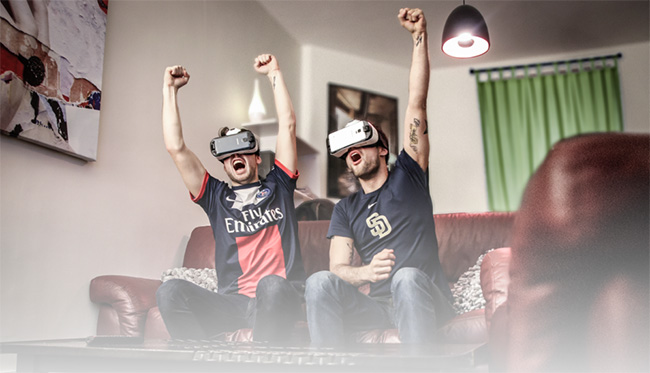 |
Image courtesy: LivelikeVR |
However, if the same setup were created in reality – i.e. broadcasting these content streams to a series of high resolution monitors in real rooms, then sports fans who already pay thousands of dollars for the biggest and highest resolution televisions, would probably jump at acquiring such a multi-screen setup (and paying premium channel content fees). In that regard, LivelikeVR’s approach may serve purpose as a proof-of-concept toward development of immersive VR home theaters.
![]()
The Promise of VR / AR
This leads us to the more likely future for successful VR and AR. After the novelty of watching VR content inside annoying and uncomfortable headsets wears off, consumers will be drawn toward the higher quality experiences of large screens in both personal and shared “real” environments, i.e. tablet and desktop monitors, living room televisions, and theatrical screens. These are where the true promise of VR and AR will be found, I think.
We already know that consumers are often willing to pay premiums in order to have HD and UHD content delivered to their living rooms. We also know they’re willing to pay premium prices for the televisions, desktop/mobile computers, and other devices that will effectively display such high resolution content. They’re also willing to pay premium prices to see movies and other programs on expanded public screens, such as in IMAX and fulldome theaters. All of these allow a better quality immersive experience – even though not necessarily in 360 degrees.
Gaming, for the most part, appeals to younger generations. VR (via VR headsets or HMDs) certainly has a place there. However, as seen repeatedly at the UploadVR Demo Day, headset VR is not at all conducive to full body movement, such as walking. One startup offering demos of a walking experience required a large floor space and a human “spotter” to attend each user. I participated in this demo wearing a partial headset that allowed me some peripheral vision of the real world “arena” (a roped off area surrounded by an array of tracking cameras) I was allowed to walk in. The combination of weak CGI graphics, distorted audio, multiple visual inputs (both my “real world” peripheral view and the on-screen video), plus sporadic image latency of the system left me stumbling and a bit disoriented within about three minutes. The headset or HMD approach to this sort of VR viewing is far less than optimal, and will likely be a deal breaker for most consumers.
If we want to make VR and AR truly successful this time around, we have to think far beyond a single vertical market like gaming, and consider how we are going to deliver the most stunning and easy-to-view programs in widely accessible VR formats.
![]()
Additional links:
Google VR (Cardboard and Jump)
![]()
